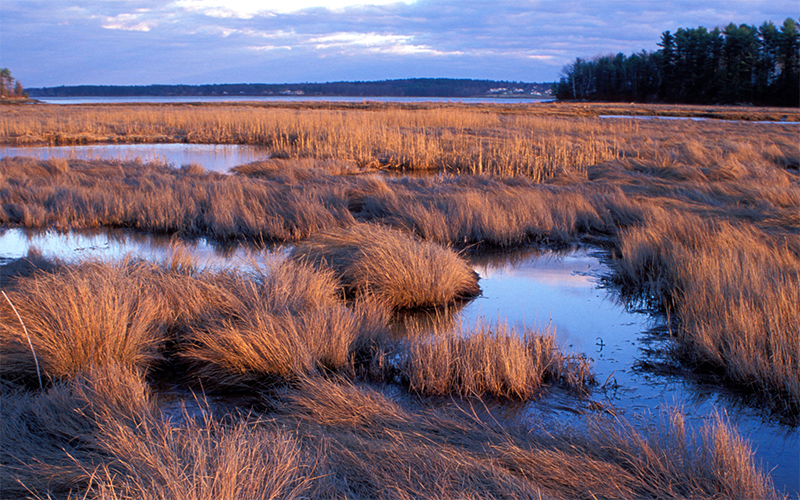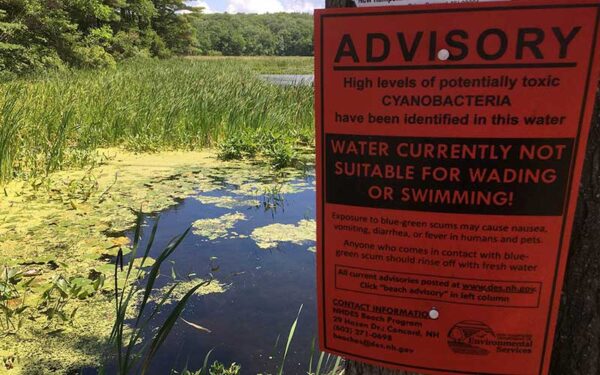
A new permit could reduce the nitrogen pollution harming the Great Bay estuary. Photo: EcoPhotography
The Great Bay estuary of southern Maine and coastal New Hampshire once abounded with vast underwater meadows of healthy seagrasses. These lush green beds produced oxygen, provided habitat, captured sediment and pollutants, and sequestered carbon. Sadly, the seagrass meadows of Great Bay and its tributaries have been drastically altered. We’ve lost more than half of the estuary’s acreage of eelgrass since the 1990s. Expanses of barren bottom and increases in invasive algae create difficult conditions for the fish, shellfish, birds, and other animals that depend on the estuary for their survival.
A primary culprit in this dramatic transformation: nitrogen pollution. Flowing into the Great Bay from wastewater treatment facilities, septic systems, and even our own lawns, this pollution is a leading cause of the unhealthy conditions now plaguing the estuary.
It’s only by reducing nitrogen pollution that we can help the estuary recover. The Environmental Protection Agency (EPA) has just proposed a new way to regulate this dangerous pollution that provides a potential path forward for our ailing Great Bay.
Where Does Nitrogen Pollution Come From?
Nitrogen pollution in the Great Bay comes from many sources. About a third derives from the 17 sewage treatment plants located around the watershed. The good news is that over the past few years, several cities and towns have upgraded their antiquated treatment facilities, and there’s some early evidence that the ecosystem is responding positively. However, a number of facilities still need improvements.
The remaining two-thirds of the nitrogen pollution results from the collective runoff of the 52 communities in the watershed. That runoff is made up of tainted rainwater washing off of roads, parking lots, and fertilized lawns into the water. The region’s thousands of septic systems also release nitrogen into the estuary.
A Comprehensive Approach to Nitrogen Pollution
We’ve been waiting more than a year for EPA to release this much-anticipated new regulatory scheme to reduce nitrogen pollution in the Great Bay estuary. Now, we finally have their proposal for a “Nitrogen General Permit.” This new permit looks holistically at all sources of nitrogen in the estuary, something that has never been done here before. This comprehensive approach could catalyze our Seacoast communities to continue improving water quality from the 17 wastewater treatment facilities around the region. It could also get cities and towns more serious about tackling the nitrogen pollution that washes into the estuary’s rivers, bays, and coasts every time it rains.
What’s hopeful about this permit is that it goes beyond the traditional regulatory route. Right now, EPA issues an individual permit with strict nitrogen limits for each wastewater treatment plant. Instead, this new general permit looks at the Great Bay estuary as a whole and sets a maximum threshold for total nitrogen beyond which scientists know seagrasses cannot survive. The threshold proposed in this draft permit would require cities and towns to reduce the nitrogen load in the estuary by about 45% over many years.
Cities and Towns Can Choose How to Cut Pollution
Reaching the lower nitrogen threshold proposed by the draft General Permit will require our cities and towns to cut their nitrogen pollution nearly in half. But they don’t have to follow a strict template to get there. Instead, each community would have leeway to determine how it can best reduce its pollution. That could mean increasing treatment at their wastewater plants, investing in ways to curtail nitrogen in stormwater, or a combination of the two.
EPA is not requiring these changes to be made overnight. They are stretched over four permit periods of five years each. It’s an achievable and affordable approach that would give cities and towns many years to build needed improvements into their budgets. The draft permit also includes a detailed plan for tracking each community’s actions and monitoring requirements to assess whether the estuary’s health is actually improving. If it’s not, EPA could re-evaluate the permit and how much nitrogen pollution is allowed.
Draft Permit Is Promising, But Scrutiny Is Required to Ensure It Meets Its Goals
We’ve advocated for a healthy Great Bay estuary for decades and will vet this new approach carefully. We are closely scrutinizing the details of the draft permit to ensure that it will lead to a more aggressive restoration of water quality and that it complies with the requirements of the Clean Water Act. We will also make sure that it includes provisions for enforcement if adequate progress is not being made.
You can play a role too. Let EPA know you support efforts to restore the health of the Great Bay estuary through more aggressive regulation of nitrogen pollution at a public hearing on the draft permit on February 19 at 6 pm:
NHDES Portsmouth Regional Office
Pease International Tradeport
222 International Drive, Suite 175
Portsmouth, NH 03801
If you’re planning to attend the hearing or would like more information, please contact Great Bay-Piscataqua Waterkeeper Melissa Paly at mpaly@clf.org.
Thank you for being a part of this critical effort to protect and restore our Great Bay estuary.




